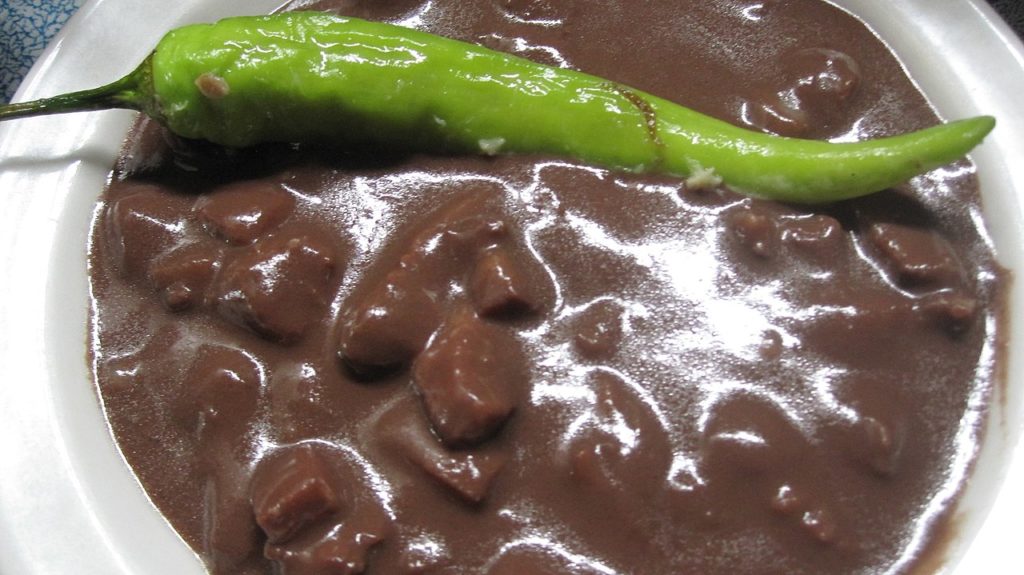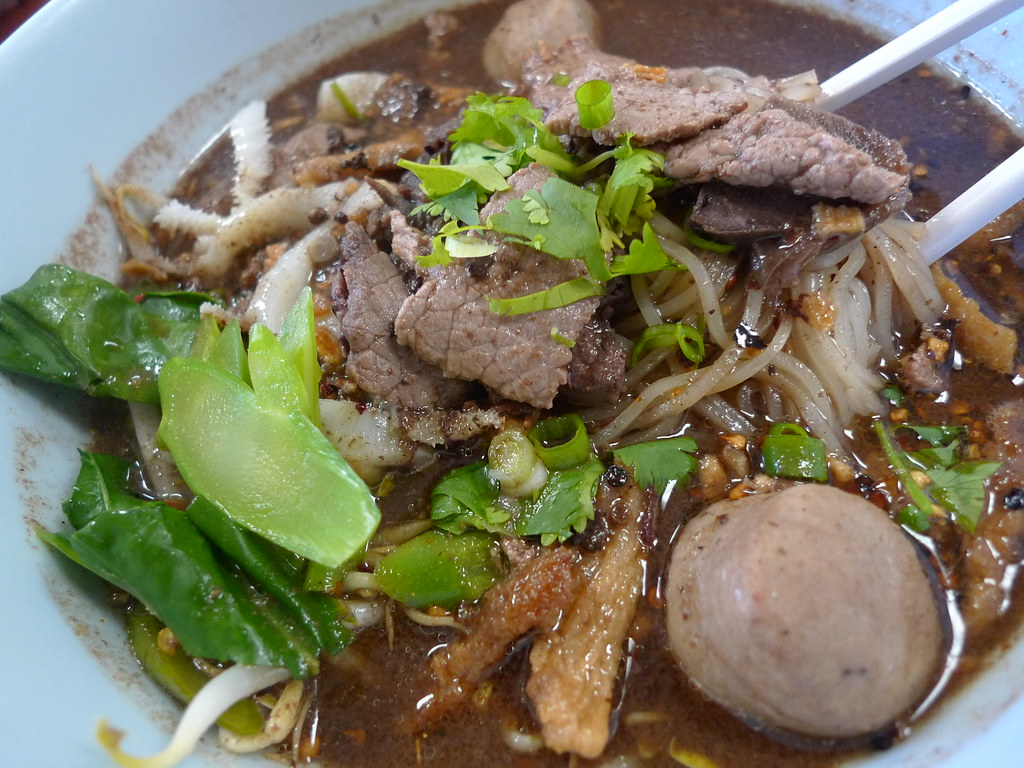Blood sausages like Indonesian urutan, Filipino pinuneg and Korean sundae, as well as blood puddings like Chinese blood curd are testament to the continued popularity of the ingredient.
In Southeast Asia, blood is mainly used as a thickener and flavour enhancer, and is an ingredient in many popular dishes.
Dinuguan
Dinuguan is a stew that’s popular in the Philippines. It consists of animal offal cooked in a dark gravy made rich with blood, and is often called “chocolate meat” due to its rich cocoa hue.
Traditionally, it is made with pig blood and internal organs, but there are variations using chicken and beef too.
 To prepare dinuguan, choice cuts and innards are sauteed with onion, ginger and garlic before adding the blood, which is typically mixed with an acidic solution like vinegar, tamarind juice or tomato sauce to impart a touch of sourness and prevent curdling.
To prepare dinuguan, choice cuts and innards are sauteed with onion, ginger and garlic before adding the blood, which is typically mixed with an acidic solution like vinegar, tamarind juice or tomato sauce to impart a touch of sourness and prevent curdling.
This stew is left to boil uncovered for at least 15 minutes until well-cooked, and then seasoned with salt, sugar and black pepper.
Savoury with a sour note, dinuguan can be served as a main meal or merienda or afternoon snack, and is usually paired with white rice or puto (rice cake).
Kuai tiao ruea
Popular around the world, kuai tiao ruea, better known as Thai boat noodles, is an aromatic noodle dish made with dark soya sauce and star anise.
Unknown to many fans, however, authentic versions of this dish feature a splash of blood in the broth.
 Pig blood is most commonly used, with cow blood coming in a close second. The blood is added to thicken the broth while enhancing the flavour, which is savoury, sour and spicy.
Pig blood is most commonly used, with cow blood coming in a close second. The blood is added to thicken the broth while enhancing the flavour, which is savoury, sour and spicy.
The blood-spiked broth is prepared with pork stock, soya sauce, star anise and other herbs, and then a soup is made with sliced pork, pork balls and rice noodles. The broth is added to the soupy noodles and topped with garlic oil before serving.
Tiet canh
While some dishes are subtly spiked with blood, tiet canh doesn’t hold back or make any pretenses.
This bright red blood pudding, a common breakfast in Vietnam, uses freshly drawn blood as its main ingredient.
 The blood is mixed with the cooked meat of the animal it comes from, usually pig or duck. Some recipes also feature goat, rabbit and bamboo rat.
The blood is mixed with the cooked meat of the animal it comes from, usually pig or duck. Some recipes also feature goat, rabbit and bamboo rat.
The blood is first mixed with fish sauce for an umami hit, before the meat is added. Finally, the soup is given a drizzle of lemon juice and garnished with peanuts, herbs like rau ram (Vietnamese coriander) and mint, and sometimes slices of liver.
Saksang
The Batak people of North Sumatra, Indonesia have a traditional blood stew called saksang among the Toba Batak group or lomok-lomok in the Karo Batak community.
The most popular protein used for the dish is pork, although other versions made with water buffalo or even dog meat can also be found.
 This dish is a good representation of the potpourri of pungent, citrusy flavours enjoyed by the Batak, whose cuisine typically features ingredients like lemongrass, torch ginger and andaliman, a wild pepper with a slightly numbing effect.
This dish is a good representation of the potpourri of pungent, citrusy flavours enjoyed by the Batak, whose cuisine typically features ingredients like lemongrass, torch ginger and andaliman, a wild pepper with a slightly numbing effect.
To cook this dish, coconut flakes and coriander are first toasted until fragrant, then pork cubes are tossed into the pot. When the meat is half-cooked, blood is added, and the stew is left to cook until the meat is tender.
Leuad paeng pet
This Laotian dish consists of herbs doused in fresh blood mixed with the offal of the animal the blood comes from, usually duck or pig, sometimes goat.
Just like tiet canh, this dish is common for breakfast, with each spoonful bursting with the flavour of fresh herbs for a morning pick-me-up. It’s also believed to have a cooling effect, and the colour red is considered auspicious.
To make leuad paeng pet, fresh blood (mixed with water) is poured over cooked meat and offal, and left for 10 minutes to coagulate into a pudding-like consistency.
It is then topped with fried shallots, chilli slices, green onions, coriander, mint leaves, Thai basil and roasted peanuts, and eaten with a squeeze of lime.
According to airasia.com













